Kinda looking at a William Buchele (attributed ) flintlock from the 70s the vendor that has it is asking just shy of 2 grand and while I like the look of it I’m not sure about the fact it’s unsigned. Do any of you all know anything about this builder? Not sure if we’re allowed to link to the people that have it or not . Thank you
You are using an out of date browser. It may not display this or other websites correctly.
You should upgrade or use an alternative browser.
You should upgrade or use an alternative browser.
William Buchele unsigned rifle?
- Thread starter Brianc
- Start date

Help Support Muzzleloading Forum:
This site may earn a commission from merchant affiliate
links, including eBay, Amazon, and others.
My best advice to you would be totally about the gun itself without any regards to an attributed maker. If the piece displays the fineness of a well built custom rifle; fit and finish, well designed and executed carving, inlays, patchbox, engraving, and everything falls into the correct elements of a particular school. Are the parts from top notch makers? Barrel maker identified, swamped, tapered, or straight? All in good condition especially the bore?
If all of these things listed come up positive and the piece fits you then you can search within yourself if the asking price is acceptable and you have the means and desire to purchase.
I base my advice from experience with other unsigned rifles that have been attributed to well known builders. A signed rifle by Buchele can go for a premium just because it is signed. No signature, it takes a lot of salesmanship and often most is just a repeat of previous owners ideas without any true provenance of truth. (BS)
Good luck
If all of these things listed come up positive and the piece fits you then you can search within yourself if the asking price is acceptable and you have the means and desire to purchase.
I base my advice from experience with other unsigned rifles that have been attributed to well known builders. A signed rifle by Buchele can go for a premium just because it is signed. No signature, it takes a lot of salesmanship and often most is just a repeat of previous owners ideas without any true provenance of truth. (BS)
Good luck
- Joined
- Nov 26, 2005
- Messages
- 5,255
- Reaction score
- 11,060
Hi,
Buchele was a well known maker during the 1950s through the early 1970s. He died in 1977. Most consider his guns representative of the long rifle revival period and he was known for his extensive carving and inlays. Many of the parts he used were hand made or by commercial makers that no longer exist because few of the commercially made parts of which we are familiar were around when he worked. Many of his guns were modern fantasy pieces that do not copy any originals. That said, he was a skilled carver and very creative. He also was the original author of the book "Recreating the American Longrifle". I've not seen an unsigned Buchele rifle.
dave
Here are some photos of a Buchele for comparison:

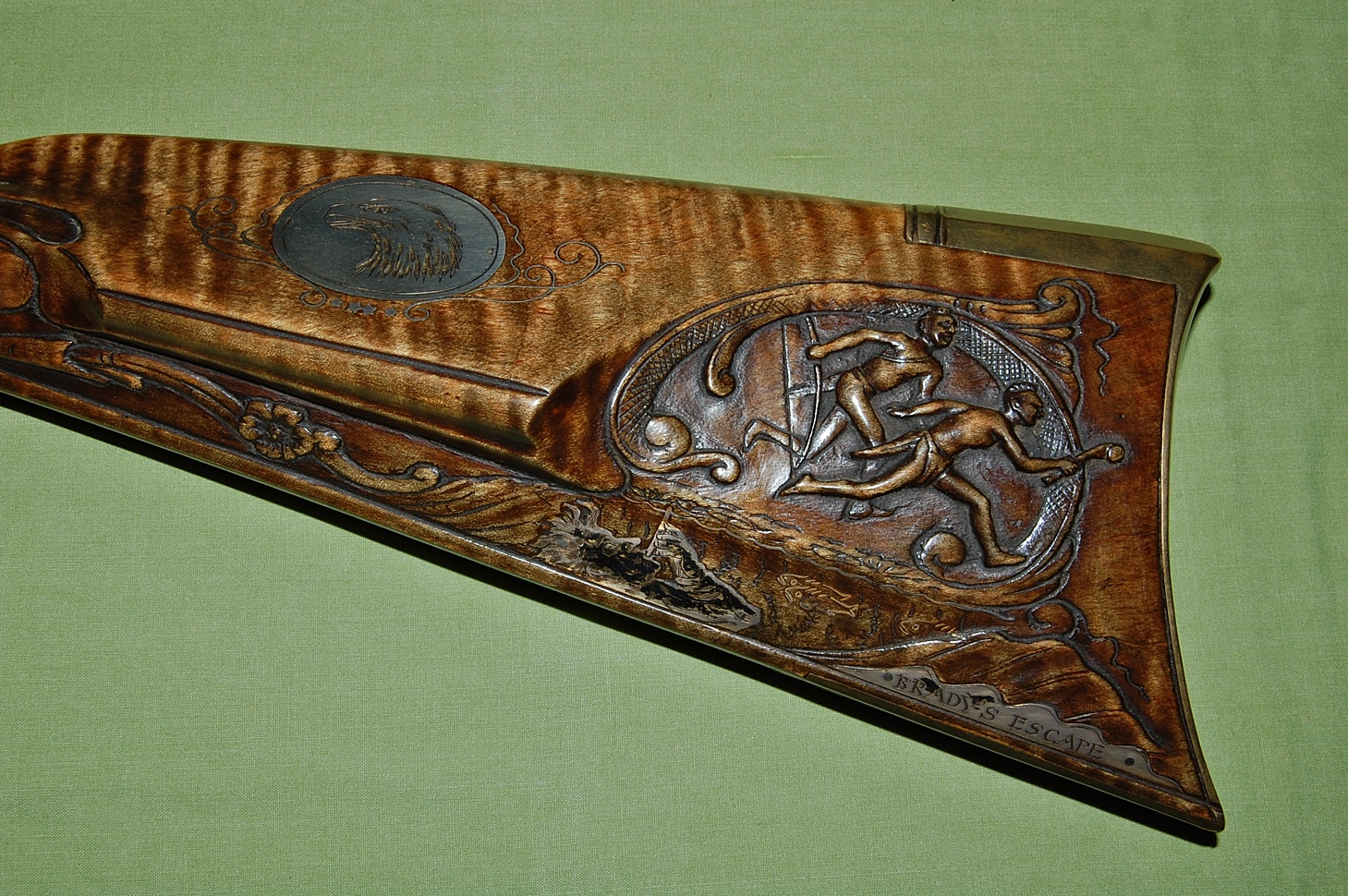
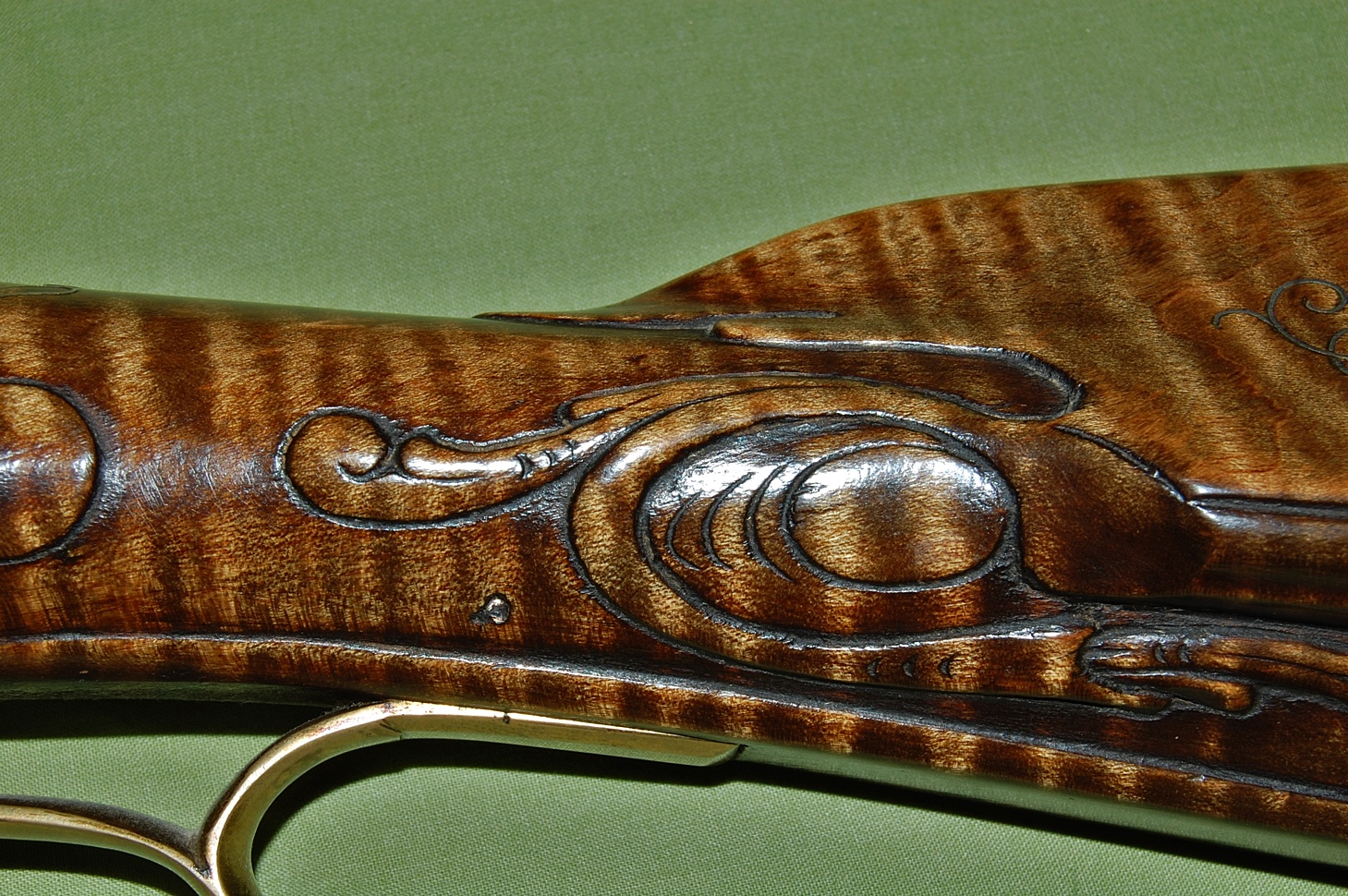
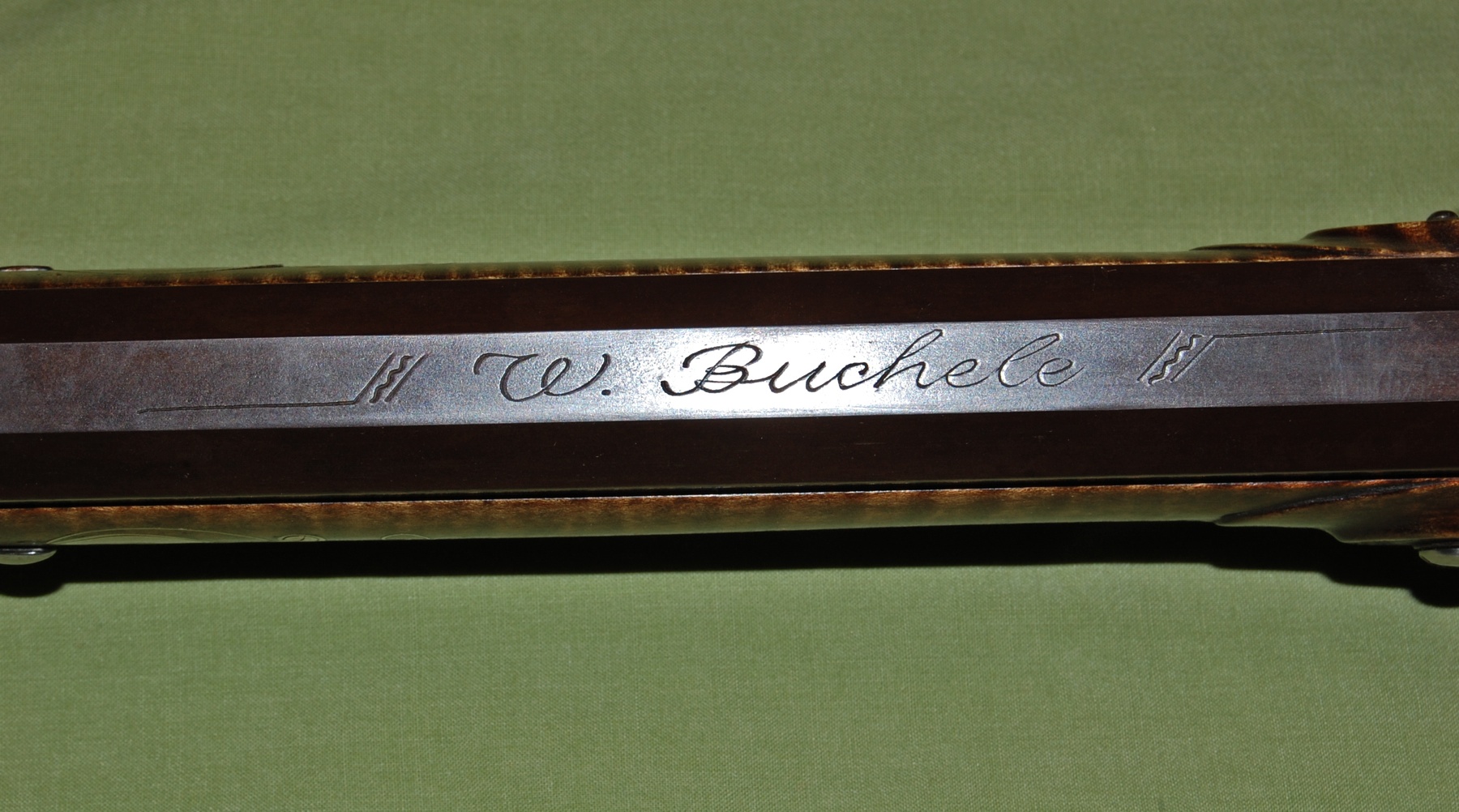
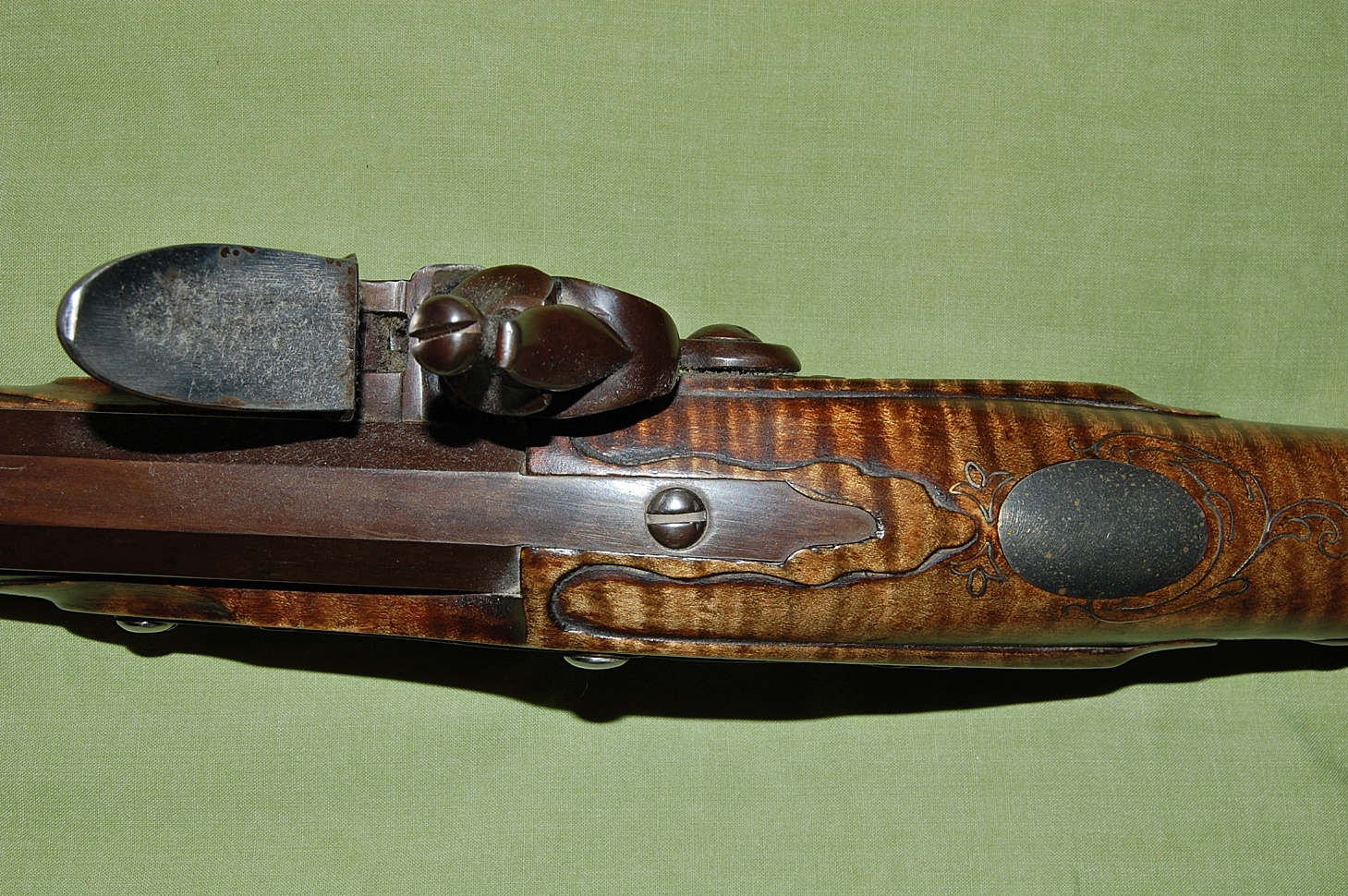
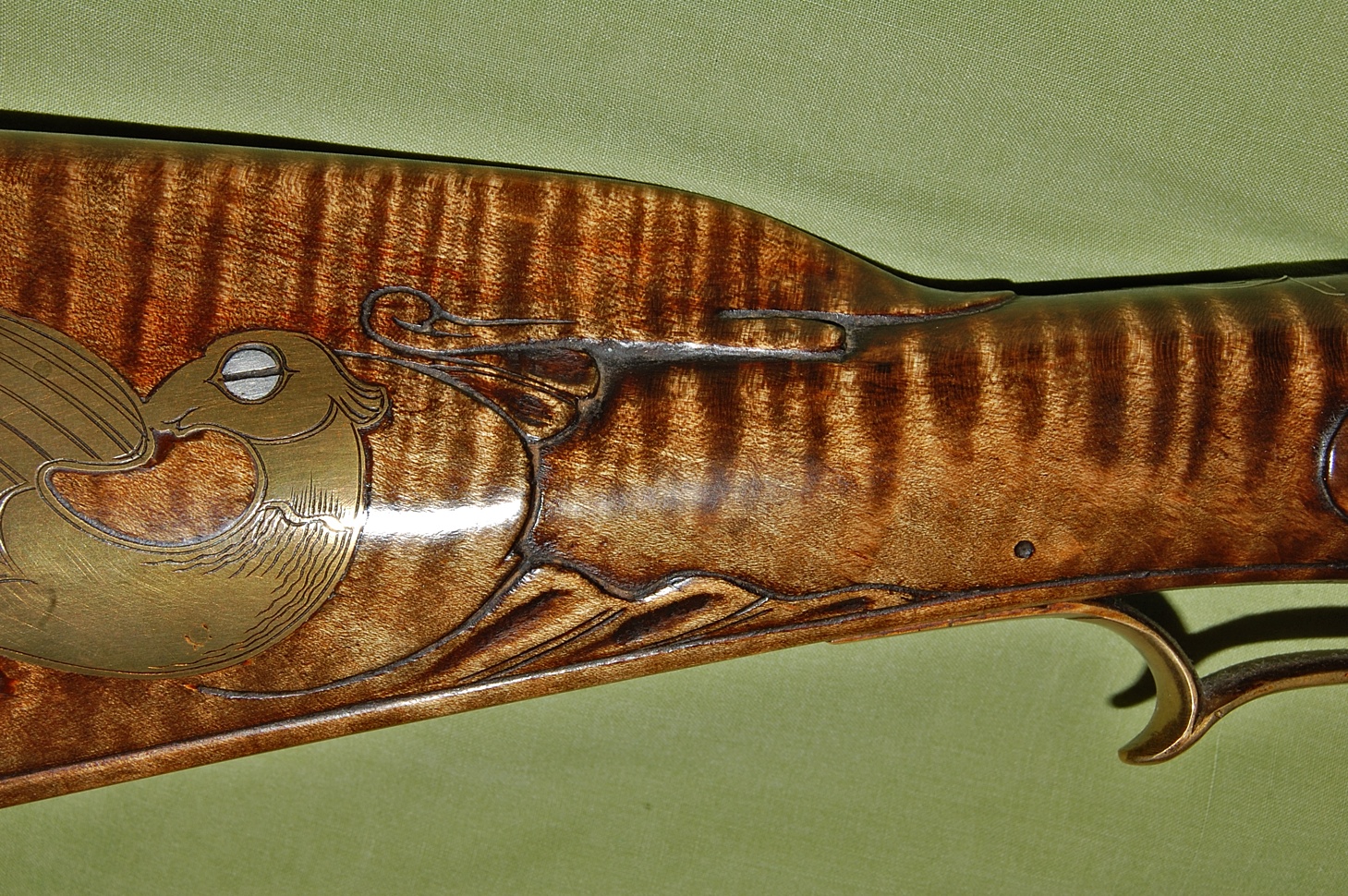
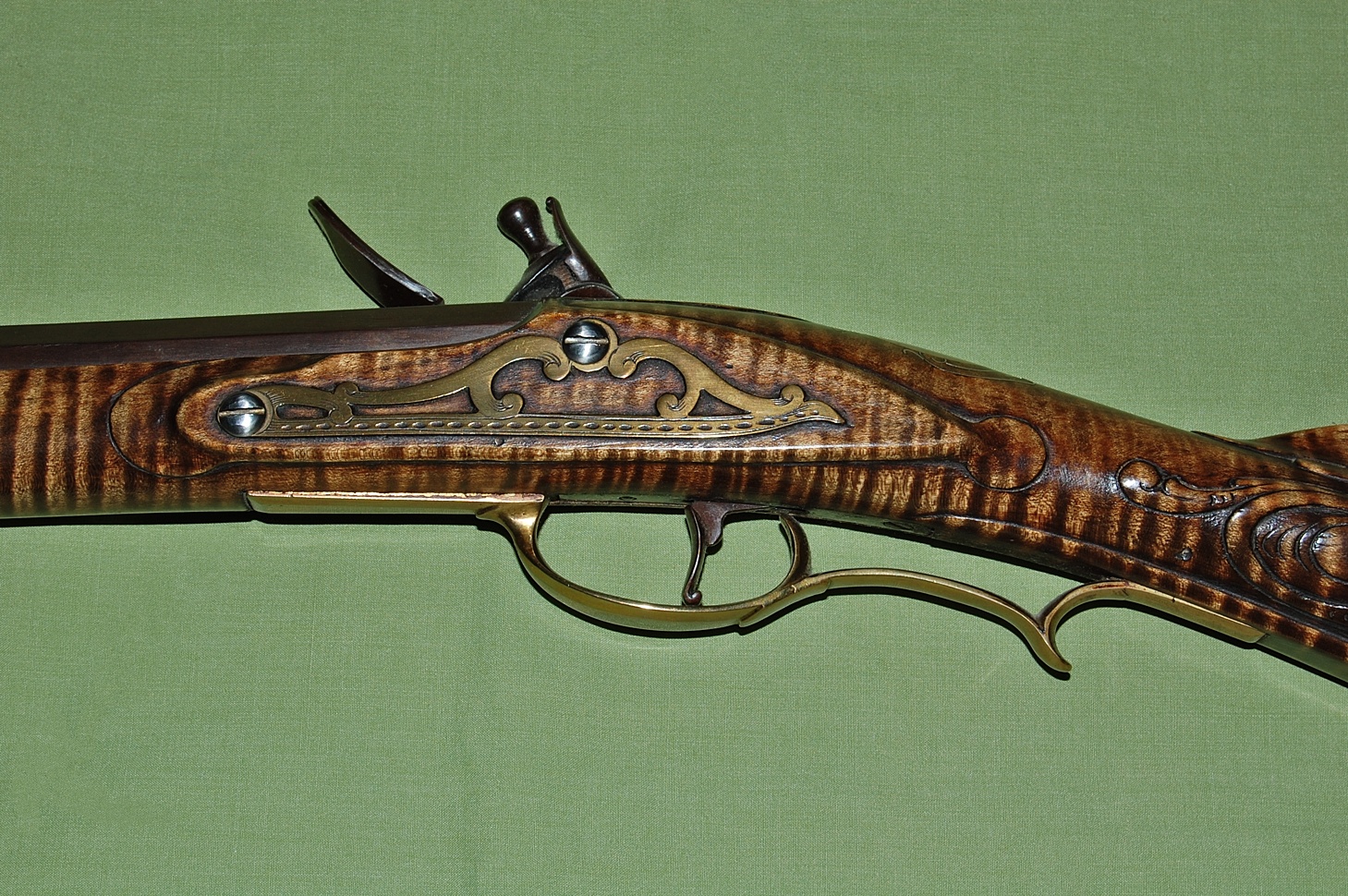
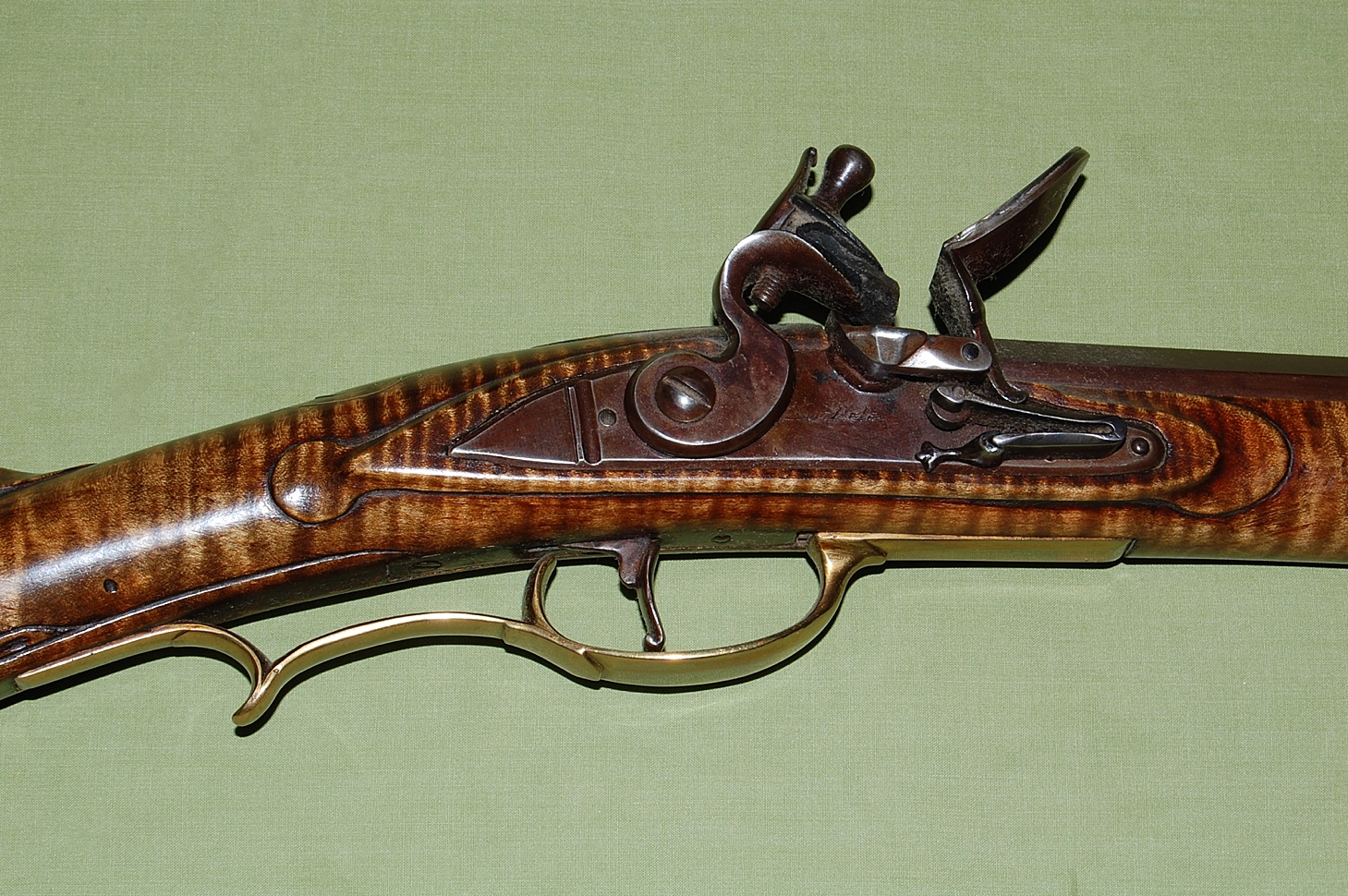
Buchele was a well known maker during the 1950s through the early 1970s. He died in 1977. Most consider his guns representative of the long rifle revival period and he was known for his extensive carving and inlays. Many of the parts he used were hand made or by commercial makers that no longer exist because few of the commercially made parts of which we are familiar were around when he worked. Many of his guns were modern fantasy pieces that do not copy any originals. That said, he was a skilled carver and very creative. He also was the original author of the book "Recreating the American Longrifle". I've not seen an unsigned Buchele rifle.
dave
Here are some photos of a Buchele for comparison:








Thank you all for the help I passed because I’m absolutely not sure and unsigned is unsure in my opinionHi,
Buchele was a well known maker during the 1950s through the early 1970s. He died in 1977. Most consider his guns representative of the long rifle revival period and he was known for his extensive carving and inlays. Many of the parts he used were hand made or by commercial makers that no longer exist because few of the commercially made parts of which we are familiar were around when he worked. Many of his guns were modern fantasy pieces that do not copy any originals. That said, he was a skilled carver and very creative. He also was the original author of the book "Recreating the American Longrifle". I've not seen an unsigned Buchele rifle.
dave
Here are some photos of a Buchele for comparison:








Ask the vendor if he/she can come with the provenance for the rifle to prove who the builder was. If he can't, then the rifle stands on its own with no premium paid for the name on the barrel. Buchele had his name on the lock. Looked stamped, not engraved, to me.
Here's Buchele's name on the lock of a known rifle of his.Buchele had his name on the lock. Looked stamped, not engraved, to me.

Spence
I bought Buchele's book in the 1970's. Ever since then, at least up until a few weeks ago when I met a fellow who knew him, I've been pronouncing his name wrong. It's pronounced Buckley.
The name on the lock always looks the same. He must have ordered several of those locks and had them stamped with his name.
I discovered Muzzle Blasts when I was about nine years old, and became an avid reader. Some time in the sixties, Mr. Buchele wrote a serialized group of articles for that magazine on building a longrifle. He was one of relatively few masters of the craft at that time, and he was a good writer, too. I remember reading his articles. Precision kits with pre-carved stocks didn't exist then, to my knowledge. Mr. Buchele told people how to make a stock from a plank, and how to fit all the other parts so they would work together properly. He was very highly respected.
You'll be lucky today to find an entry-level longrifle from a custom builder for $2,000. Add carving, a patchbox, and some inlays, and the price will spiral skyward. Worth every penny, too. The point being that I agree with @Captjoel in his assessment. If you need a longrifle, consider that one on its own merits, regardless of who built it. I would not buy it strictly as a collectible Buchele, if it isn't marked or signed as such.
I would also agree with @dave_person in that many of Mr. Buchele's rifles were not built as copies of specific early guns in adherence to any traditional "school" of gunsmithing. Mr. Buchele sort of founded his own school. The carving on the rifle in Dave's post exemplifies this. The relief carving of the two native men, aft of the cheek piece on that rifle, is extraordinary.
Notchy Bob
You'll be lucky today to find an entry-level longrifle from a custom builder for $2,000. Add carving, a patchbox, and some inlays, and the price will spiral skyward. Worth every penny, too. The point being that I agree with @Captjoel in his assessment. If you need a longrifle, consider that one on its own merits, regardless of who built it. I would not buy it strictly as a collectible Buchele, if it isn't marked or signed as such.
I would also agree with @dave_person in that many of Mr. Buchele's rifles were not built as copies of specific early guns in adherence to any traditional "school" of gunsmithing. Mr. Buchele sort of founded his own school. The carving on the rifle in Dave's post exemplifies this. The relief carving of the two native men, aft of the cheek piece on that rifle, is extraordinary.
Notchy Bob
I've been told that Buchele made locks, himself. Does anyone have definitive information about that?The name on the lock always looks the same. He must have ordered several of those locks and had them stamped with his name.
Spence
David William Doerr
32 Cal
- Joined
- May 25, 2022
- Messages
- 4
- Reaction score
- 36
I am Wm Buchele's oldest grandson and spent lots of time with him in his basement during the late 50s and early 60s when I stayed with my grandparents during the summer.
I believe he had rough castings made of some of the components that went into his firearms and the locks were probably some of those. Note the castings were very rough - he put a lot of work into fabricating and engraving the locks (and other parts).
The "Buchele" on the locks appear to be engraved to me. On the firearms I own, the year is stamped under the "Buchele" name, and there is a difference in the appearance of the two...that and I have the year stamps but no "Buchele" stamp.
Also my grandpa believed in making as many rifles as he could turn out rather than spending an undue amount of time on a single rifle. To that end, he'd be working on a number of locks at the same time, and later would work on rifles to accept the locks and other parts. For example, one of my rifles has "1960" on the lock and "1962" on the brass ammo cover.
One part I know he didn't make himself: the barrels - those were purchased.
I believe he had rough castings made of some of the components that went into his firearms and the locks were probably some of those. Note the castings were very rough - he put a lot of work into fabricating and engraving the locks (and other parts).
The "Buchele" on the locks appear to be engraved to me. On the firearms I own, the year is stamped under the "Buchele" name, and there is a difference in the appearance of the two...that and I have the year stamps but no "Buchele" stamp.
Also my grandpa believed in making as many rifles as he could turn out rather than spending an undue amount of time on a single rifle. To that end, he'd be working on a number of locks at the same time, and later would work on rifles to accept the locks and other parts. For example, one of my rifles has "1960" on the lock and "1962" on the brass ammo cover.
One part I know he didn't make himself: the barrels - those were purchased.
Thank you for joining the forum and posting about your grandfather, @David William Doerr . He did some remarkable work.
I appreciated the comment about turning the rifles out, and not spending excessive time on any one. That sounds like the procedure used by the real old-time gunmakers. Time was money. They had standards to maintain, but they learned to work efficiently.
I am curious... What sort of work did he do for a living, and did he eventually start building rifles full time? What kind of professional training did he have? His artwork, as in his rifles as well as his drawing, is extraordinary. Was he self-taught, or formally trained? As for the gunsmithing and rifle-building, did he apprentice with an older master, or were those skills all self-taught?
I was a kid in the fifties and early sixties, but I was fascinated by my dad's collection of antique firearms, and I was an avid reader of Muzzle Blasts at a pretty young age. There were not many people building guns for sale in those days, nor were there many new components available. A lot of guns were cobbled together out of assorted old parts by amateurs. Your grandfather set a different standard.
Best regards,
Notchy Bob
I appreciated the comment about turning the rifles out, and not spending excessive time on any one. That sounds like the procedure used by the real old-time gunmakers. Time was money. They had standards to maintain, but they learned to work efficiently.
I am curious... What sort of work did he do for a living, and did he eventually start building rifles full time? What kind of professional training did he have? His artwork, as in his rifles as well as his drawing, is extraordinary. Was he self-taught, or formally trained? As for the gunsmithing and rifle-building, did he apprentice with an older master, or were those skills all self-taught?
I was a kid in the fifties and early sixties, but I was fascinated by my dad's collection of antique firearms, and I was an avid reader of Muzzle Blasts at a pretty young age. There were not many people building guns for sale in those days, nor were there many new components available. A lot of guns were cobbled together out of assorted old parts by amateurs. Your grandfather set a different standard.
Best regards,
Notchy Bob
Last edited:
I am Wm Buchele's oldest grandson...
David,I met a fellow who knew him, I've been pronouncing his name wrong. It's pronounced Buckley.
That's cool! I used to spend summers at my grandparent's house, too, in PA.
Can you confirm the pronunciation of the name Buchele?
I don't like mispronouncing names, even in my mind.
David William Doerr
32 Cal
- Joined
- May 25, 2022
- Messages
- 4
- Reaction score
- 36
Thank you all for your interest in my granddad. I will try to answer your questions.
First, I confirm that we pronounce the name "Buckley". Most of the family here in the US spelled the name "Buechele", but my grandfather's dad and uncle both spelled their name Buchele - I don't know why. One older Buechele family member I met pronounced his name "Bew-shell". I believe my great-great grandfather, who was born in Germany, pronounced his name "Bew-shel-la" - well not exactly, but that's the best approximation I can make. If you know a little German you probably know how it's pronounced from the spelling.
William Buchele had three careers during his lifetime. During the years before World War One he worked for a while as a sign painter for the Toledo (Ohio) sign company and then as a machinist, probably for his father.
He also raced bicycles during that decade.
After returning from the war he married and again worked as a sign painter. If not right away, he eventually owned the Modern Sign Company in Toledo.
As a hobby, he did very nice oil paintings - self-taught, but with the same level of talent you've seen in his firearms. He also did wood carving during that time.
During the decade before World War II he became interested in astronomy and made telescopes, including the mirrors. At first these were small telescopes, but gradually they became quite large. One of those he mounted on the garage roof, equipped with an electrically-driven mechanism to follow the stars. I believe I have a photo somewhere of an even larger telescope he built for Toledo University.
His telescope mirror-making (which were quite large in diameter) led to him opening his own optical shop, and he received a lucrative government contract to make roof prisms for periscopes during the war years.
About the time he retired in the mid 50s he carved his first gun stocks. He and my father participated in the annual deer hunting ritual and he gave my father a nice Springfield-based hunting rifle with a terrific carved stock - dated 1957.
My grandfather was very proud of the fact that he was born in Louisville. His mother and father (before getting married) both lived in Toledo, but in the early 1890s his mother's family moved to Louisville. His father-to-be followed her down to Kentucky, married, and my grandfather was born there in 1895. They moved back to Toledo a few years later, where granddad's brothers and sisters were all born. I believe his being born in Kentucky led to his interest in recreating Kentucky rifles.
He went to a gun show in Columbus periodically to show his wares and gradually made a name for himself and his rifles.
As far as turning lots of rifles out, I feel that he didn't do that so much for the money, but that he just wanted to get as many of his rifles out there as he could. It was his retirement hobby. When I stayed at my grandparents house - he would be up at 7, eat breakfast at the kitchen counter and head right down to the basement and start work.
In the early 70s when the bicycle-riding resurgence began he was very excited to join us younger family members - my parents, aunt and uncle, me and my sister. Lot's of fun riding with grandpa...
He made a series of "1776" rifles to commemorate the anniversary. The following year he became ill and didn't feel up to building firearms, so he returned to oil painting. He painted a good number of those before he died in September.
He was one of those people who are able to teach himself how to do things - and he was able to do anything he set his mind to and do it well. The only exception to his self-taught skills that I know of were his initial employment as a sign painter and as a machinist - his machining skills certainly served him well in his optical business and firearm-making.
First, I confirm that we pronounce the name "Buckley". Most of the family here in the US spelled the name "Buechele", but my grandfather's dad and uncle both spelled their name Buchele - I don't know why. One older Buechele family member I met pronounced his name "Bew-shell". I believe my great-great grandfather, who was born in Germany, pronounced his name "Bew-shel-la" - well not exactly, but that's the best approximation I can make. If you know a little German you probably know how it's pronounced from the spelling.
William Buchele had three careers during his lifetime. During the years before World War One he worked for a while as a sign painter for the Toledo (Ohio) sign company and then as a machinist, probably for his father.
He also raced bicycles during that decade.
After returning from the war he married and again worked as a sign painter. If not right away, he eventually owned the Modern Sign Company in Toledo.
As a hobby, he did very nice oil paintings - self-taught, but with the same level of talent you've seen in his firearms. He also did wood carving during that time.
During the decade before World War II he became interested in astronomy and made telescopes, including the mirrors. At first these were small telescopes, but gradually they became quite large. One of those he mounted on the garage roof, equipped with an electrically-driven mechanism to follow the stars. I believe I have a photo somewhere of an even larger telescope he built for Toledo University.
His telescope mirror-making (which were quite large in diameter) led to him opening his own optical shop, and he received a lucrative government contract to make roof prisms for periscopes during the war years.
About the time he retired in the mid 50s he carved his first gun stocks. He and my father participated in the annual deer hunting ritual and he gave my father a nice Springfield-based hunting rifle with a terrific carved stock - dated 1957.
My grandfather was very proud of the fact that he was born in Louisville. His mother and father (before getting married) both lived in Toledo, but in the early 1890s his mother's family moved to Louisville. His father-to-be followed her down to Kentucky, married, and my grandfather was born there in 1895. They moved back to Toledo a few years later, where granddad's brothers and sisters were all born. I believe his being born in Kentucky led to his interest in recreating Kentucky rifles.
He went to a gun show in Columbus periodically to show his wares and gradually made a name for himself and his rifles.
As far as turning lots of rifles out, I feel that he didn't do that so much for the money, but that he just wanted to get as many of his rifles out there as he could. It was his retirement hobby. When I stayed at my grandparents house - he would be up at 7, eat breakfast at the kitchen counter and head right down to the basement and start work.
In the early 70s when the bicycle-riding resurgence began he was very excited to join us younger family members - my parents, aunt and uncle, me and my sister. Lot's of fun riding with grandpa...
He made a series of "1776" rifles to commemorate the anniversary. The following year he became ill and didn't feel up to building firearms, so he returned to oil painting. He painted a good number of those before he died in September.
He was one of those people who are able to teach himself how to do things - and he was able to do anything he set his mind to and do it well. The only exception to his self-taught skills that I know of were his initial employment as a sign painter and as a machinist - his machining skills certainly served him well in his optical business and firearm-making.
Great post, @David William Doerr !
I don’t own any of your grandfather’s work, but I have always appreciated his rifles, writing, and drawing. It’s good to know a little more about the man behind the guns.
A war veteran, an artist, and a self-made man… my hat’s off to him!
Notchy Bob
I don’t own any of your grandfather’s work, but I have always appreciated his rifles, writing, and drawing. It’s good to know a little more about the man behind the guns.
A war veteran, an artist, and a self-made man… my hat’s off to him!
Notchy Bob
That's a fascinating family history about a skilled artisan from another time.
Thanks for the painting the picture for us!
Thanks for the painting the picture for us!
David William Doerr
32 Cal
- Joined
- May 25, 2022
- Messages
- 4
- Reaction score
- 36
Before Recreating the American Longrifle there came...




- Joined
- Feb 28, 2019
- Messages
- 3,664
- Reaction score
- 4,655
A noted maker indeed though it seemed he was more interested in the carveing than the locks the books George Shumway put out based on Mr Bucheles teaching are still a very good' how to' reference and the basic methods though pertaining to long rifles are eaqualy transferable to any gun of that time period ,so if would be makers seek advise, I steer them to that book. Rudyard
- Joined
- Jan 24, 2005
- Messages
- 3,403
- Reaction score
- 6,929
Thank you, Brianc for raising this post.
David, you’ve brought back memories of his writing in Muzzle Blasts and I learned a lot from him.
One thing that I still do, and this is exemplified in the pictures above by Dave, and that is the orientation of the slots in the screws, nothing jars me so much as nonaligned screw slots.
Your grandfather went to the trouble of making them look right, not by over tightening but by a little extra fitting.
However the slots were not alway on the straight line but were part of the overall look.
In the above photos there is one of the bird on the patch box finial and if you look closely the slot is slanted and forms the iris of the eye and is aligned with the eye’s corners.
That is artistic indeed.
David, you’ve brought back memories of his writing in Muzzle Blasts and I learned a lot from him.
One thing that I still do, and this is exemplified in the pictures above by Dave, and that is the orientation of the slots in the screws, nothing jars me so much as nonaligned screw slots.
Your grandfather went to the trouble of making them look right, not by over tightening but by a little extra fitting.
However the slots were not alway on the straight line but were part of the overall look.
In the above photos there is one of the bird on the patch box finial and if you look closely the slot is slanted and forms the iris of the eye and is aligned with the eye’s corners.
That is artistic indeed.
Similar threads
- Replies
- 9
- Views
- 580
- Replies
- 5
- Views
- 676
- Replies
- 9
- Views
- 2K



